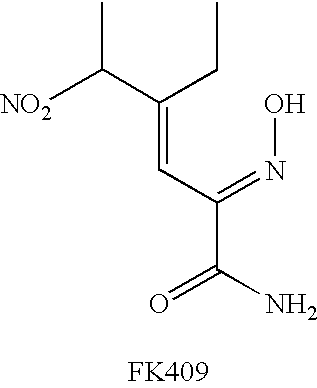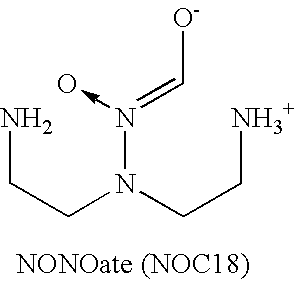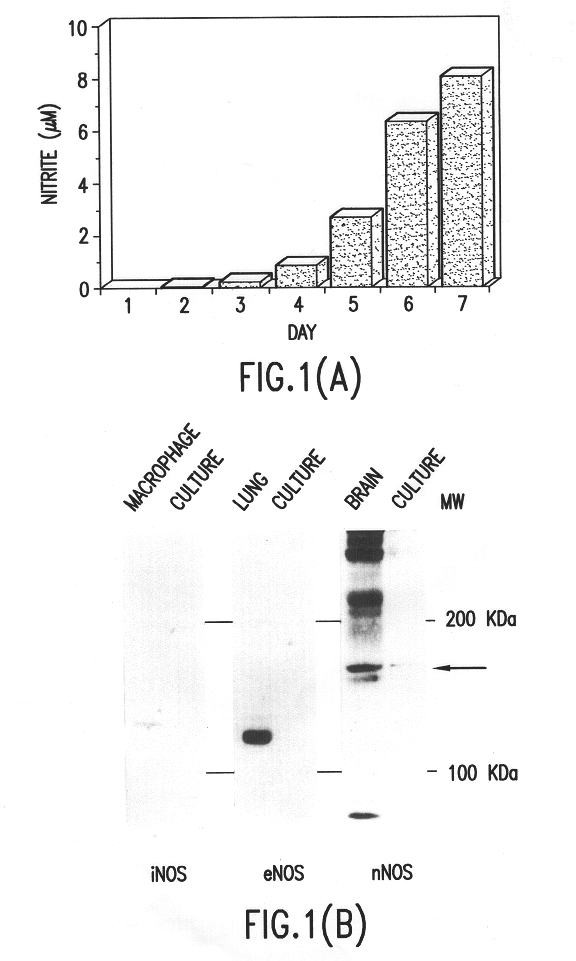Neurotrophic factor secretion promoters
a technology of neurotrophic factor and promoter, which is applied in the direction of heterocyclic compound active ingredients, biocide, drug compositions, etc., can solve the problems of inability to use the increase in no amount of tissues in the treatment of neurodegenerative diseases, and the connection between no and neurodegenerative diseases (alzheimer's disease, etc.) has not been clarified
- Summary
- Abstract
- Description
- Claims
- Application Information
AI Technical Summary
Problems solved by technology
Method used
Image
Examples
example 1
Role of Neuronal-Nitrogen Oxide Synthase (nNOS) in NO Production in the Primary Culture of Cerebral Neocortex Neuron
The following experiment was done in order to confirm the NO production by neural cells, and to clarify which isozyme of three nitric oxide synthase isozymes (References el and e2) (neuronal type; nNOS, endothelial type; eNOS and inducible type; iNOS) is involved with the NO production, The cultured neural cells were prepared by using the neural cells from the cerebral neocortex of rat embryo (E18), and culturing thereof in a serum free medium for 7 days (Reference e3). The supernatant of the culture medium was collected, and the concentration of nitrite was determined, which was used as an index for the total amount of NO production (FIG. 1A). The concentration of nitrite was determined by Griess' method (Reference e4). During the cultivation, the accumulation of nitrite in the supernatant was increased. The expression of NOS in the cultured cells was detected by West...
example 2
Effects of NO Donor on the BDNF Expression
From the finding that the inhibition of NO synthesis in the cultured brain neural cells increased the expression of BDNF gene, it was clarified that endogenous NO affect the regulation of BDNF gene expression. This finding was further studied by directly adding exogenous NO into the culture system. A spontaneous NO donor, SNAP, was employed in this experiment since SNAP is widely used because the cytotoxicity thereof is weaker than that of other NO donors (Reference e5). SNAP was added to the culture system at various concentrations, and 3 hours and 5 hours thereafter, the BDNF MRNA was determined by quantitative RT-PCR, and the BDNF protein in the cells was determined by EIA, in the same manner as in Example 2. As expected as the above, it was confirmed by determining the nitrite that NO was released from the NO donor (FIG. 2A).
In this system, SNAP inhibited the expression of BDNF mRNA at a quite high dose (1000 .mu.M), but it increased dos...
example 3
Effects of an NO Donor on BDNF Release
The effects of an NO donor on the BDNF release were studied in order to clarify the inhibitory effects of SNAP at a high dose on the BDNF protein accumulation. First, the measurement of BDNF concentration in the culture supernatant was tried, but the concentration of BDNF therein was below a detection limitation value of an ordinary EIA, which was considered that the released BDNF immediately combines with the cell surface, even with the trkB receptor. Then, using an anti-pan-trk receptor antibody, a sandwich immunoassay was tried in order to determine the BDNF combined with a trk B receptor on the cell surface. When adding BDNF at a prescribed concentration into the culture system and determining the BDNF therein, there was observed a good correlation between the amount of BDNF to be added and the measured values (FIG. 3A), and hence, the effects of an NO donor on the BDNF release from the neural cells were studied using this newly established ...
PUM
 Login to View More
Login to View More Abstract
Description
Claims
Application Information
 Login to View More
Login to View More - R&D
- Intellectual Property
- Life Sciences
- Materials
- Tech Scout
- Unparalleled Data Quality
- Higher Quality Content
- 60% Fewer Hallucinations
Browse by: Latest US Patents, China's latest patents, Technical Efficacy Thesaurus, Application Domain, Technology Topic, Popular Technical Reports.
© 2025 PatSnap. All rights reserved.Legal|Privacy policy|Modern Slavery Act Transparency Statement|Sitemap|About US| Contact US: help@patsnap.com



